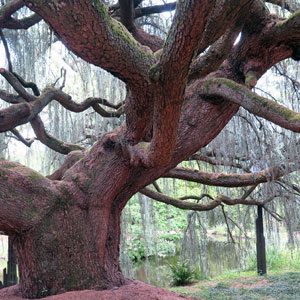A remarkable tree is often an old one but also an imposing or large tree!
Remarkable trees thus, represent the legacy left by previous generations. Whether they represent an historical or sentimental value, they are often valuable. They have been preserved, kept or forgotten and have thus crossed decades or millennia to reach venerable ages and/or sizes. Sometimes these trees are senescent, and they arouse our curiosity and awaken our desire to protect them by a ‘remarkable tree’ status.
In France, this ‘ remarkable tree ‘ status allows the classification of the tree to the local urban Plan and thus protects the tree from an inconsequential felling.
Do you know that nowadays very few trees planted will have the privilege of being senescent or remarkable? Do you know that the lifespan of a tree in town is close to 30-40 years?
Tall trees are scaring us.
Photo below: The same tree essence, about 6 meters high, reduced to a strict minimum vital (and not for a very long time…).
The fear of a tree fall is probably the cause of many unjustified pruning of trees.
Although the ‘ 0 ‘ risk does not exist, cases of death due to the fall of a tree are relatively rare.
Trees are more likely to cause injuries by falling branches. Statistics indicate that deaths due to illnesses such as cancer, poisoning, injuries and all kinds of daily accidents are much more frequent!
And, paradoxically, it is often an excessive pruning of trees that make them dangerous, by weakening them!!!
How to check if a tree is dangerous?
In a very busy place, a tree expert is able to carry an expertise on the risks caused by trees. He prioritizes tree weaknesses and he measures with advanced technology such as tomograph (imagery by sound waves) the importance of a cavity. With a resistographe he controls the thickness of the residual walls of trees that present a decay. Statistical tools (QTRA) also allow for the definition of acceptable risk mathematical thresholds according to the target that a tree could reach in its falling.
A soil analysis can also highlight a poor anchorage or an underground fragility…
Before pruning: make sure there is a need to prune such tree! Today’s tree could become a remarkable tree for your children or grandchildren!
We can advise you on the care to provide to trees in order to maintain them healthy in the long term. We can also help you manage your old trees.
The more a tree is pruned, the more prone it is to diseases and attacks of wood-destroying fungis. The tree is weakened. A tree planted in a soil and climate that is adapted to it, and which is in full physiological health, is ‘ anatomically ‘ designed to be well anchored to the ground and solid!

